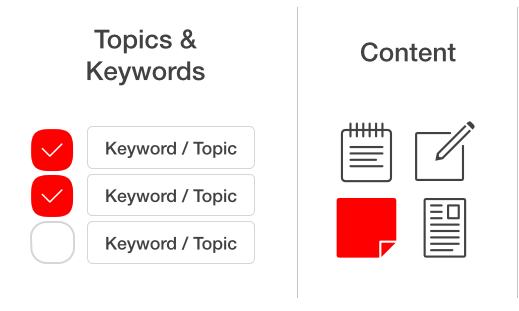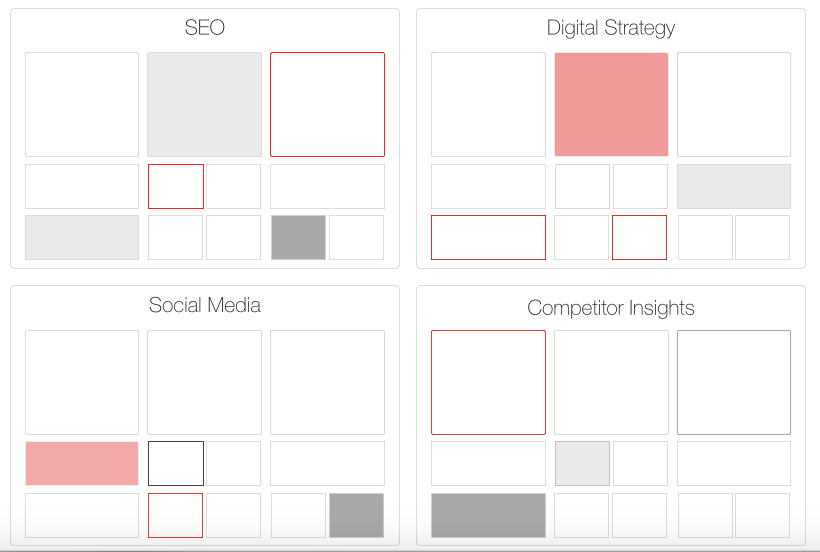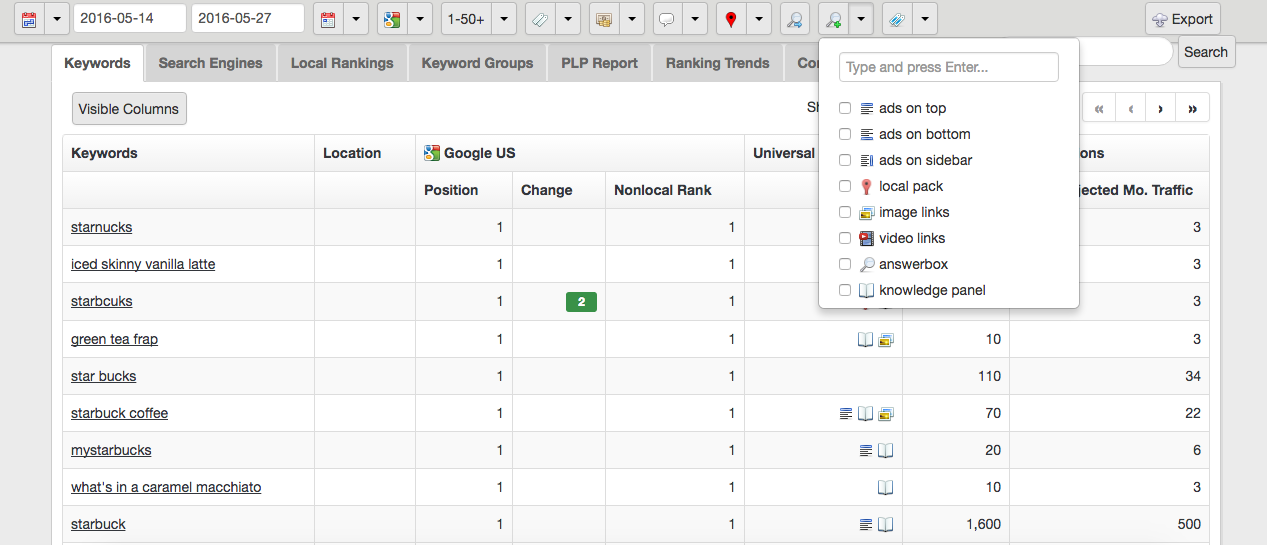Wherever you are on the content marketing continuum, chances are you still have your share of challenges. In fact, according to Content Marketing Institute’s 2016 report, more than half of us are still struggling to produce engaging content, produce it consistently, and determine its effectiveness.
In this post, we present 7 content challenges many marketers and SEOs face and provide solutions to improve findability, engagement, and conversions based on using the data available from a marketing intelligence and SEO platform.
Challenge #1: You’ve missed the topic target
If you write it, they will come – doesn’t really work for content marketing. Just producing content to fill your site with a daily blog, or some other arbitrary reason for creating content, usually results in content that doesn’t get read, or at the very least, doesn’t get read by the right audience.
The problem? Writing content to fill a content quota or other content goal may mean your content is less focused on your audience and more focused on publishing. In short, you’ve missed the topic target.
 The goal of content marketing is to establish authority, gain trust, and become a resource for customers and potential customers. The only way to grow your audience successfully is to answer the questions they’re asking. Knowing what questions are relevant and how to respond is probably one of the biggest challenges facing content marketers today.
The goal of content marketing is to establish authority, gain trust, and become a resource for customers and potential customers. The only way to grow your audience successfully is to answer the questions they’re asking. Knowing what questions are relevant and how to respond is probably one of the biggest challenges facing content marketers today.
Solution: Content topics from search insights.
When more than half of our website traffic is the result of organic search, it seems logical to get our content ideas from organic search data. In fact, there are many good reasons to use keyword and competitor data gathered from organic search results, including:
- Your content will reflect the language your audience is using when they ask questions or search on the web for solutions in your industry.
- You can monitor which keywords and topics are improving or declining in rank to determine where to create new content and where to refresh old content, saving you time and resources creating content that may not be relevant any more.
- Keeping content up to date with current keywords allows you to optimize the content you already have without spending the time and money creating new content and improving ranking positions.
- Watching competitor keyword ranking progress will give you new content ideas to win back your audiences.
Challenge #2: Your audience isn’t sharing your content
Creating content isn’t enough to build audiences and increase conversions. Now that search engines take into account social signals when deciding the relevancy of your content, you should too. Ultimately, the shareability of your content will determine its ultimate success or failure as a vehicle to drive traffic to your website.
 According to a recent New York Times study, people share information most to bring valuable and entertaining content to others and to define ourselves to others. Content marketers can tap into the sharing mindset by monitoring social channels to determine what our audiences consider valuable and entertaining content.
According to a recent New York Times study, people share information most to bring valuable and entertaining content to others and to define ourselves to others. Content marketers can tap into the sharing mindset by monitoring social channels to determine what our audiences consider valuable and entertaining content.
Solution: Social media channels and engagement data.
Before you create more content, measure the shareability of the content you already have. Looking at what’s already being shared and where it’s being shared will give you a compass for creating new content and deciding how and where to share it.
Using social media intelligence you can:
- Understand which channels work for you and which channels are working for your competitors.
- See exactly what content is driving traffic, conversions, and revenue from each social channel.
- Compare your share of voice to your competitors.
Knowing what content is driving traffic from social media for you and your competitors will help you determine the sharing mindset of your audiences. You’ll know what content they consider valuable and make content creation and content optimization decisions based on audience preferences. Build your editorial calendar around topics that will enable your audiences to define themselves as people who follow and share thought leaders and trusted industry resources.
Challenge #3: You don’t really know your audience
We can learn a lot about our target audiences by looking at our current customers and understanding their pain points and preferences. However, just looking at current customer profiles will not give you all the information you need to interest and engage your current prospects or to attract new audience members.
If you have audience persona profiles based solely on your current customers, you may not be resonating with those members of your audience who aren’t as far along in the realization of their needs or understanding of your industry. You may be missing opportunities to connect with the people who influence the buying decision and are researching products and solutions far ahead of the decision maker.
What about those audience members who move along the buyer journey only to drop out before the conversion? These negative audience personas can be as influential to your content creation strategy as your positive audience personas are.
Solution: Better audience personas.
Improve your ability to reach your audiences by understanding their current pain points and the questions they’re asking about the challenges they’re facing now.
Get insights into audience preferences through search data to learn:
- How audiences are talking about your industry natively.
- Where your audiences are located.
- Which search engines they’re using.
- Which devices they use.
- Which social channels they prefer.
- The exact content they share.
- The types of content they engage with most.
- What competitor content is gaining their attention.
- Who is influencing the buyer decisions.
- Who should be, but isn’t engaging with your brand.
Challenge #4: Your competitors have your audience’s attention
Is someone else engaging with your audiences and beating you in the search engine results pages? Do you know who your audience is finding and what content is most popular? You should. If you don’t know who’s winning audience attention over you, you may be surprised to find that you have more competitors for audience share than just the brands that compete with you for sales.
 In an ecosystem filled with content, our greatest competitors for audience attention will most likely include brands outside our direct product competitors. Other competitors may include bloggers, industry thought leaders, paid media, and industry publications. While you may not be able to outrank established publications, you may discover places where you want to be included in round-up articles, paid advertising, or contributed article opportunities.
In an ecosystem filled with content, our greatest competitors for audience attention will most likely include brands outside our direct product competitors. Other competitors may include bloggers, industry thought leaders, paid media, and industry publications. While you may not be able to outrank established publications, you may discover places where you want to be included in round-up articles, paid advertising, or contributed article opportunities.
Solution: Competitor monitoring and discovery.
Knowing everyone in your content space, and how your content ranks versus theirs, will help you make better decisions about what content to create, which topics to focus on, and which mediums to use.
Use competitor monitoring and discovery to:
- Keep track of direct competitors and note shifts in messaging.
- Get insights into where to place content emphasis based on your ranking and traffic data versus your competitors.
- Monitor your findability versus your competitors to understand what content audiences are most likely to see when they search using the keywords you care about.
- See which keywords are gaining ground or losing traction for you and your competitors to track audience interest.
Challenge #5: You don’t know what’s working and what’s not
You might have access to lots of different data sources, or you might not. Regardless of the availability of data, sometimes it’s just a matter of getting the data you need when you need it and in simple enough format. If you’re like most of us, you need data that you can use now to easily gain insights without a lot of extra work sifting through irrelevant data or piecing together a lot of disparate data to garner a few actionable insights.
 If you don’t have access to clear, concise data with an easy user interface, you may not really know what’s working and what’s not and much of your content marketing efforts may be a shot in the dark. It’s no wonder that the majority of content marketers are still struggling to prove the effectiveness of their efforts and to tie content to bottom line goals.
If you don’t have access to clear, concise data with an easy user interface, you may not really know what’s working and what’s not and much of your content marketing efforts may be a shot in the dark. It’s no wonder that the majority of content marketers are still struggling to prove the effectiveness of their efforts and to tie content to bottom line goals.
Solution: Automated customizable reporting templates.
Data reports aren’t just a way to satisfy the management team. Use automated custom reporting options to keep track of the data you care about. You may even want to set daily notifications to watch trends or to find out about potential problems before they become problems. Customized reports can also be viewed as dashboards to keep you apprised of the data you want to monitor.
If you’re monitoring more than one site, set-up your customized dashboard and reporting templates once and copy to as many other sites as you choose. Use automated reporting to get at-a-glance insights into daily crawl data.
Use marketing intelligence data in automated reports to:
- Keep track of competitors and their content.
- Determine content topics based on keyword ranking trends.
- Watch content performance across marketing channels.
- Monitor social media signals.
- Note SEO recommendations for keywords and content.
Challenge #6: Your content isn’t getting found
There are a lot of reasons why your content isn’t getting found by your audiences. Discovering what might be going wrong can be a challenge. If your problem is with a specific piece of content, or a single campaign, the cause can be discovered at the message, medium, or method levels. If the problem is more global than that, you may want to consider a complete site and content audit.
Things are changing all the time within the search engines. Between constant roll-outs of algorithm changes, both large and small, and changes in the layout of the search engine results pages, keeping content and websites up to date and optimized continues to be a challenge for brands large and small.
 If you aren’t getting the results you’d like from your content efforts, you may have page structure errors or crawlability issues you aren’t aware of that are negatively impacting your marketing efforts and website traffic. At the very least, you’ll want to make sure all your content is optimized for the latest keywords and written for maximum search results.
If you aren’t getting the results you’d like from your content efforts, you may have page structure errors or crawlability issues you aren’t aware of that are negatively impacting your marketing efforts and website traffic. At the very least, you’ll want to make sure all your content is optimized for the latest keywords and written for maximum search results.
Solution: Site and content audit
A site and content audit will measure the overall health of your website and landing pages as well as provide insights into fixes that you need to make now and practices you’ll want to change moving forward. While the results of an audit can be overwhelming, be sure you can get your recommendations sorted by importance, difficulty, and risk.
Use a site and content audit to discover:
- Keyword and content improvements
- Proper keyword inclusion.
- New keywords you should be using, but aren’t.
- Competitor keywords.
- Proper use of tags.
- Optimized meta descriptions.
- Page structure and crawlability
- H1-H4 tag errors.
- Title tag recommendations.
- URL optimizations.
- External link health.
- HTTP errors.
Making changes to the structure of your pages and following good SEO suggestions can improve your findability by an average of 20% within 60 days after a site and content audit.
Challenge #7: Your content is appearing too low on the page
Recent changes in search engine results page layouts have created a new challenge for marketers – knowing the true rank of their content. Is it possible that your content is ranking in the top three organic search results and not showing up above the fold, or even on the first page? With the new SERP layouts, it’s happening a lot more often than you’d think.
 Now, organic content is competing with a lot more than other organic content. Besides an increased number of ads at the top (up to four), organic content now needs to compete with a knowledge panel, shopping results, and videos. If you don’t have a way to know your true rank, you may be missing opportunities or focusing your efforts in the wrong areas.
Now, organic content is competing with a lot more than other organic content. Besides an increased number of ads at the top (up to four), organic content now needs to compete with a knowledge panel, shopping results, and videos. If you don’t have a way to know your true rank, you may be missing opportunities or focusing your efforts in the wrong areas.
Solution: Universal search.
Universal search data is a highly visual way to quickly see what else is appearing on the page with your organic content. Using insights from Universal Search, marketers and SEOs can decide whether to optimize content for better rankings, or focus on paid methods.
Most importantly, Universal Search data helps marketers avoid cannibalizing their organic content with paid media placements and visa versa. Knowing everything that appears on a search results page and understanding true rank for organic and paid content allows marketers and SEOs to make decisions about where to put their efforts.
Universal Search can help make organic content and PPC decisions, including:
- Optimizing content on pages with fewer non-organic results.
- Optimizing local SEO to rank in local pack.
- Placing ads on pages with more non-organic results.
- Putting effort into getting included in knowledge graph results.
Whatever your challenges, setting up a system for determining content topics and then monitoring and measuring the resulting content assets is something most of us are looking for better ways to accomplish. If you’d like to see how a marketing intelligence and SEO platform can help you meet your challenges, give us a shout and we’ll show you around.

